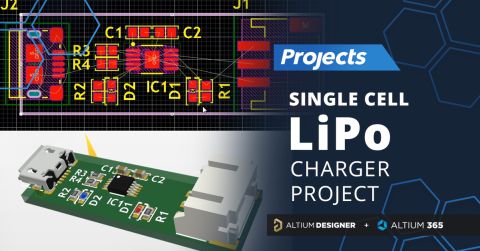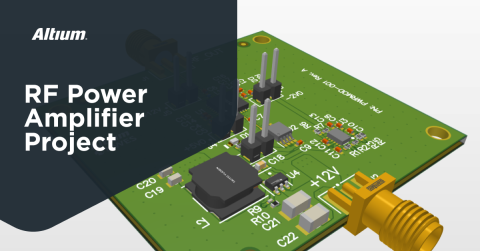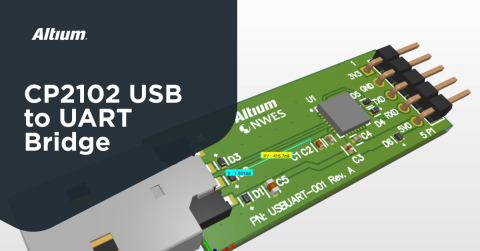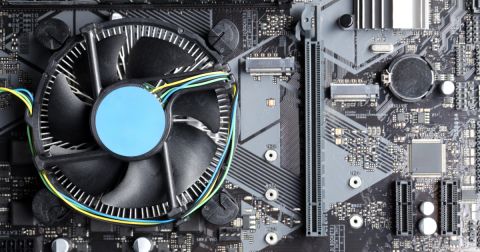Create a Buck-Boost Power Supply

In this series of articles, we’re looking at the design and implementation of the main types of power regulators and converters you might use in an electronics project. I gave a graduate engineer who I mentor a series of requirements to demonstrate each of these types and have recorded the results here so you can work through the same exercises and hopefully come up with the same results.
The next switching regulator is the last in our switching regulator series for students. My graduate engineer’s design requirements were that the power supply should be able to maintain a stable output voltage, even if the supply voltage is higher or lower than the required output. In other words, it should be able to both step-up and step-down the supply voltage to deliver a stable supply output for the load device. This type of switching regulator is extremely useful, especially for battery-operated devices or devices with several different power supplies that it switches between, depending on set conditions or the mode of operation required.
My requirements for this design were as follows:
- Input Voltage range 3.0 to 4.2 V
- Output Voltage 3.3 V
- Output Current 200 mA
Several topologies can be used to achieve this step-up and step-down operation using one regulator. In this article, we will discuss the following:
- Buck-Boost converter
- SEPIC
- Ćuk
- Flyback
The Buck-Boost converter is a type of switched-mode power supply that uses both boost converter and buck converter functionality in one circuit. A combination of both step-up and step-down circuits can provide a stable output voltage over a wide range of input supply voltage. Also, both boost and buck converters use very similar components that are simply rearranged depending on which converter type is required.

In the above diagram, you can see the similarities of both topologies. Also, the same inductor can be used for both topologies:

In the combined Boost-Buck converter topology shown in the above diagram, you can see that the control unit, which is an oscillator, PWM, and feedback controller, has the capability to select between boost converter operation and buck converter operation.
Operation of a Buck Converter
In a buck converter mode, the transistor switch TR2 is turned off, and the transistor switch TR1 is switched ON and OFF by the square wave PWM controller using a high frequency as described in the controller’s data sheet.
When the transistor switch TR1 is ON, current flows through inductor L, energizing its magnetic field and subsequently charging the output capacitor C and the output load. The Schottky diode D1 is turned OFF by the presence of a positive voltage at its cathode.

When the transistor switch TR1 is OFF, inductor L becomes the current source while its magnetic field is collapsing, generating a back EMF, and reversing the polarity of the voltage across inductor L. This turns the Schottky diode D1 ON, allowing current to flow through the Schottky diode D2 to the output load.

Operation of a Boost Converter
In a boost converter mode, the transistor switch TR1 is turned ON, and the transistor switch TR2 is switched ON and OFF by the square wave PWM controller. When the transistor switch TR2 is ON, the input current flows through inductor L and transistor switch TR2 to the negative supply terminal (ground), energizing inductor L’s magnetic field. During this phase of the cycle, the Schottky diode D2 cannot conduct as its anode is being held at the voltage of the ground terminal by the TR2 transistor switch providing a conduction path.
During this period, the output load is supplied entirely by the charge held by capacitor C, which was charged on previous cycles.

When the transistor switch TR2 is OFF, the inductor L is energized, and capacitor C is partially discharged. During this phase of the cycle, the inductor L generates a back EMF. EMF energy will depend both on the current rate of change when transistor switch TR2 switches ON and OFF, and also on the inductance.
At this point, the polarity across inductor L is reversed, and the back EMF voltage now adds to the input voltage, so it is now higher than, or at least equal to, the input voltage. The Schottky diode D2 is now switched ON, and so the circuit supplies the output load and charges the capacitor C so that it will be ready for the next cycle phase where the transistor switch TR2 is ON.

The transfer function between input and output can be expressed by:

Operation of a SEPIC Converter
A SEPIC, or Single Ended Primary Inductor Converter, is a type of converter that can also step-down, step-up, or supply a voltage that is equal to the power supply to the output load. The topology of the SEPIC converter is typically based on a boost converter and an inverted boost-buck converter. This type of converter is popular for battery applications due to its efficiency and reliability.

When transistor switch S1 is ON, current flows through inductor L1, and the current through L2 becomes negative. The energy flowing through L1 comes from the input source. Diode D1 is ON, and capacitor C1 supplies the electrical power and increases the amplitude of the current flowing through inductor L2. This increases the energy stored in its magnetic field, with the current being supplied from the capacitor C2.

When transistor switch S1 is OFF, the current flowing through capacitor C1 becomes equal to the current flowing through the inductor L1. Since inductors do not allow an instantaneous current change, the current flowing through inductor L2 will still be in a negative direction. Therefore, when transistor switch S1 is OFF, the power to the output load is delivered from inductors L1 and L2. The capacitor C1 will be charged during this period by inductor L1.

The transfer function between input and output can be expressed by:

Operation of a Ćuk Converter
The Ćuk converter (also referred to as the ‘two inductor inverting converter’) is an inverting SEPIC converter with flyback topology. This converter is similar to the others in this list in that it is capable of step-up and step-down operations. The energy used by the converter is transferred to the capacitor once the transistor switch is open. This means that the primary energy storage element in the Ćuk converter circuit is the capacitor, unlike most other switching power supply topologies where the main energy storage element is an inductor.
The topology uses either two separate inductors or a single component called a coupled inductor.
The Ćuk converter consists of two inductors, two capacitors, a transistor switch, and a diode. This converter is an inverting type, meaning that the output voltage is negative with respect to the input voltage.
The capacitor C1 is used to transfer high-frequency energy. It is connected alternately to the input and the output of the Ćuk converter between a parallel transistor switch and a diode. Two inductors, L1 and L2, are used to transform the voltage input source E and voltage output source U into current sources. For a short time, the inductors can be considered as current sources as they are able to maintain a constant current. Charging the output capacitor C2 with the current source (the inductor) is a method of preventing resistive current limiting and the associated energy loss.

The Ćuk converter can work in continuous current mode, discontinuous current mode, and discontinuous voltage mode.
The transfer function between input and output can be expressed by:

Operation of a Flyback Converter
A flyback converter is an isolated DC-DC switching converter that can step-up or step-down an input voltage. This converter uses galvanic isolation to separate the output from the input. A split inductor is used to form a transformer for this isolation.
You can see that the flyback DC-DC converter’s topology is quite similar to the boost-buck converter topology; the difference is that transformer is used instead of an inductor. The operating principles for both of these converter types are also very similar.
When the switch is ON, the transformer’s primary coil is connected to the input voltage source. This allows current flow in the primary coil to increase, and the magnetic field around the primary coil stores energy in the transformer. The voltage which is induced in the secondary coil is negative, which means that the diode is reverse biased, and the output capacitor supplies the output load.

When the switch is OFF, the primary coil current decreases, and the magnetic field reduces. The secondary coil’s voltage is positive, and current flows through the forward-biased diode to supply energy to the capacitor and the output load.

The transfer function between input and output can be expressed by:

There are other types of switching DC-DC power supplies with the ability to step-up and step-down voltages, but we will leave the discussion of these for another time.

Operation of a Boost-Buck Converter
The topology that was chosen by my graduate engineer for this task was a boost-buck converter. However, all the other topologies we have discussed will equally be able to perform the required operation needed for this task, so you can experiment with these different topologies. Experimenting with different topologies and trying to achieve the same results may seem pointless at first, but these exercises will significantly increase your knowledge and understanding of power supplies. Best of all, it will give you the upper hand should you ever get faced with a task or job, or university/college exercise, where you need to choose a power supply for a device or application.
The IC chosen by my graduate engineer was the Texas Instruments TPS63000, which is an average price device with a positive adjustable output voltage and the capability to maintain 1.2 A of output current in step-down mode and 800 mA of output current in step-up mode operations.

This IC has been chosen because of its low price, good availability, high efficiency at the required load (up to 200 mA), it’s pretty cheap and straightforward component stack-up, and simple PCB layout.
This IC is designed primarily for portable battery-powered devices, especially those powered by two or three-cell alkaline, NiCd, NiMH, or single-cell lithium-polymer or lithium-ion batteries.
This IC regulator can be purchased from most electronic component distributors such as Mouser, Digi-Key, Farnell, Arrow, Vertical, RS Components.
The TPS63000 is one of the TPS6300X series of DC-DC boost-buck regulators that have an adjustable output voltage. The other two devices in this series have fixed output voltages of 3.3 V and 5 V. We have chosen the adjustable voltage variant because of the flexibility it offers. With just a few more calculations and changing a few components, the regulator can easily be converted from a 3.3 V output to a 5 V output and vice-versa.
This regulator IC comes with Device Enable (EN), under-voltage lockout, over-temperature protection, and power save mode functions.
The Device Enable (or EN) function allows control of the regulator, shutting it down if required. This function uses a dedicated EN pin, which can be pulled high when the regulator operation is enabled and pulled down when the regulator needs to be shut down. This function can be controlled by an MCU, an observing or supervisor device, or using a simple transistor or logic gate.
The under-voltage lockout prevents the regulator from starting up when the input supply voltage is lower than the regulator’s threshold voltage. This function prevents incorrect regulator operation when the input supply voltage is out of limits. When the input supply voltage is within limits, then the regulator automatically restarts.
The over-temperature protection function allows the regulator to shut itself down when the internally sensed temperature exceeds a set threshold, protecting the IC and the rest of the circuit.
The power save mode uses a dedicated PS/SYNC pin. With the pin pulled high, the power save mode is disabled, and with pulled low, it is enabled. Connecting a clock signal to this pin will allow us to implement frequency synchronization.
Schematic Design
You will see that the schematic design was not complicated as both the circuit design and the required components were recommended in the device data sheet.
As usual for the first step, the output voltage was set to 3.3 V by using the following formula given in the data sheet:

All the variable values can be found in the data sheet. The feedback voltage VFB is about 500 mV, and our required output voltage VOUT is 3.3 V. The resistor R2 should be lower than 500 kΩ, so to start with, the chosen value was 200 kΩ.
The initial calculated value of R1 was 1.12 MΩ. For convenience, this value was changed to be 1 MΩ and using this value, the calculated value of R2 becomes 178 kΩ.
The data sheet also recommended adding an additional feedforward capacitor Cff in parallel with R2 to provide more stable feedback and improve the control performance. The formula for calculating the feedforward capacitor was also provided in the data sheet as follows:

So, using this equation, the calculated capacitor value was 2.2 pF.
The data sheet also includes a few inductor recommendations; however, my graduate engineer decided to calculate and select the inductor on their own. The required formula was also given in the data sheet:


First, the duty cycle of the boost mode was calculated:

As this is the boost operation duty cycle, the value of input voltage Vin used should be the lowest operating voltage at which the converter will operate in the application. In our case, this is 3.0 V. The output voltage Vout is 3.3 V.

Now, as we have calculated the boost mode duty cycle, the other variables are:
The converter switching frequency f = 2.5 MHz
The inductor value can be changed during the course of the calculations, but we start with a value of 2.2 uH, as this was recommended in the data sheet circuit design.
The output current was chosen to be 300 mA to provide a sufficient margin for error.
The efficiency of the converter was chosen to be 0.94. This was read from the efficiency curves provided in the data sheet graph:

The value read from the graph is approximate, but do not fear using approximate values in engineering as all electronic design is based on the use of margins and approximate values.
Using these values, the calculated peak inductor current is:

The LQH31CN2R2M03L inductor produced by Murata was chosen. Its inductance is 2.2 uH, its rated current is 430 mA, and it has the same small size as an SMD 1206.
The input capacitor using the data sheet recommendations should be at least 4.7 uF, and the output capacitor value should at least be 15 uF. However, these values can be increased above these recommendations as this will reduce the input and output voltage ripple. My graduate engineer has chosen for this application to use a 10 uF capacitor for the input and two capacitors with values of 10 uF and 22 uF for the output.
There is also an additional RC low pass filter for the VINA control supply pin. The RC filter values for the resistor and capacitor were taken from the data sheet.
The chosen connectors this time were strip terminal blocks available from Molex.

These connectors are easy to solder and can be used with female header wires, which are readily available everywhere and can carry 200 mA of current with ease.
All these choices lead to this designed schematic for the TPS63000 DC-DC boost-buck regulator:

PCB Design
You will see that PCB design was also quite simple for this exercise. The recommendations were taken from the data sheet, and only minimal design changes were required.

The component placement was initially done according to the data sheet recommendations:

As we have two separate grounds for the power ground PGND and control circuit ground GND, which are connected with the Net Tie component, the net Tie was placed at the bottom close to the GND pin:

The next step in the PCB layout was to manually route the traces. This technique allows for easier control of the current flow in the PCB and can show many details.

The thermal considerations for the PCB design were not very strict because the design was formed for <200 mA output current applications. The maximum power dissipation of the regulator IC was calculated in the data sheet as follows:

By calculating the power dissipation at 3.3 V with 200 mA output, plus including the dissipation losses resulting from having an efficiency of around 90%, we will get:
Wide polygons were used for the input and output traces, plus the ground planes on the top and bottom. These were assessed to be more than sufficient for the application.
The power polygons were then added:

Finally, the ground planes were added to the top and bottom layers:



Conclusion
There are many applications in modern electronic gadgets where the combined ability to both step-up and step-down a voltage in a single regulator is required. This is especially necessary for battery applications, as battery voltage tends to decrease during discharge. Other applications could be supercapacitors or a regulator that can work from several supplies, for example, usually using a battery but switching to a USB power supply when connected to recharge the battery.
I have discussed several different topologies that are available for step-up and step-down voltage regulators. These include a non-isolated boost-buck converter, a SEPIC converter, a Ćuk converter, and an isolated flyback converter. Which one you should choose will depend on the application, budget, any circuit or operational difficulties, availability, and many other aspects. Experimenting with using different topologies for your applications can be a great idea as it develops your knowledge about them. There may well come a time when you will be asked to design a circuit that requires such a regulator; it will be easier for you to choose between these topologies if you have already tried them all out.
This application’s component design was not complicated as the data sheet includes pretty clear explanations, recommendations, and guidelines. However, in other situations, you may find that step-up and step-down regulators’ circuit design can require very complicated circuits, which can involve many calculations and careful component choices. Other topologies can also require the use of more inductive components, which tend to increase circuit complexity and the cost of implementing the design.
You saw that the PCB design for this converter was also relatively easy because the data sheet provided the layout recommendation, which was easily adapted. However, for applications with higher load currents, the PCB design can become very complicated because of the more complex thermal management requirements. Also, for applications with higher current requirements, there will be a need to consider EMI effects.
You can find the design files for many of my projects released under the open-source MIT license on GitHub. You’re free to use any of the circuits or projects as you wish, even for commercial projects. You’ll find details of the devices that we discuss in my massive open-source library. You’ll also find details of a huge range of different components contained in this library as well.










